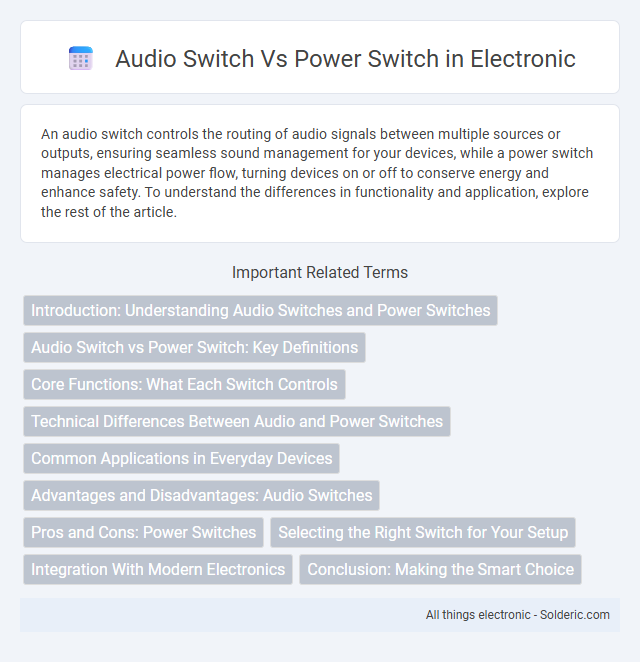An audio switch controls the routing of audio signals between multiple sources or outputs, ensuring seamless sound management for your devices, while a power switch manages electrical power flow, turning devices on or off to conserve energy and enhance safety. To understand the differences in functionality and application, explore the rest of the article.
Comparison Table
| Feature | Audio Switch | Power Switch |
|---|---|---|
| Purpose | Routes audio signals between devices | Controls electrical power flow to devices |
| Function | Switches different audio sources or outputs | Turns power ON or OFF for circuits or devices |
| Common Usage | Audio systems, mixers, headphones | Home appliances, industrial machines, lighting |
| Signal Type | Low-voltage audio signals (analog or digital) | High-voltage electrical current |
| Safety | Minimal electrical hazard | Requires insulation and safety certifications |
| Switching Mechanism | Relays, mechanical or electronic toggles | Mechanical toggles, push buttons, circuit breakers |
| Example Devices | Audio selector switches, headphone switches | Light switches, power strips, circuit breakers |
Introduction: Understanding Audio Switches and Power Switches
Audio switches control the routing of audio signals between different input and output devices, enabling seamless selection of sound sources without manual reconnection. Power switches regulate the flow of electrical current, turning devices or circuits on and off to control their operational status safely. Both switches serve distinct roles in electronic systems, with audio switches optimizing signal management and power switches ensuring electrical control.
Audio Switch vs Power Switch: Key Definitions
An audio switch controls the routing of audio signals between multiple inputs and outputs, enabling seamless selection and switching of audio sources without signal loss. A power switch manages the flow of electrical power to devices or circuits, ensuring safe and efficient on/off control for powering equipment. Understanding these key definitions helps you choose the right switch type based on whether you need to handle audio signal paths or electrical power control.
Core Functions: What Each Switch Controls
An audio switch controls the routing of audio signals between multiple input and output devices, allowing you to select which audio source plays through your speakers or headphones. A power switch, on the other hand, manages the electrical power supply to a device, turning it on or off to control its operational state. Understanding the core functions helps you choose the right switch for managing audio preferences versus device power control.
Technical Differences Between Audio and Power Switches
Audio switches are designed to handle low voltage and low current signals with minimal distortion and noise, ensuring high fidelity sound transmission. Power switches, on the other hand, are built to manage higher voltages and currents, often incorporating features like thermal protection and robust contacts to safely control electrical loads. Your choice between these switches depends on the application requirements for signal integrity versus power handling capacity.
Common Applications in Everyday Devices
Audio switches frequently appear in devices like headphones, sound mixers, and home theater systems to control audio signal routing without interrupting power supply. Power switches are commonly found in household appliances, computers, and lighting fixtures, enabling you to safely control the electrical current flow and power status. Understanding the distinct functions of these switches helps optimize your device's usability and energy management.
Advantages and Disadvantages: Audio Switches
Audio switches provide seamless signal routing between multiple audio sources, ensuring minimal signal loss and high-quality sound transmission. Their compact design and low power consumption offer efficient audio management, but they may introduce slight latency or crosstalk depending on the switch type and quality. Compared to power switches, audio switches lack high current handling but excel in precise audio control for multimedia applications.
Pros and Cons: Power Switches
Power switches offer robust control over electrical devices with high load capacity and effective safety features, making them ideal for managing power circuits. However, they typically consume more energy and generate heat, which may affect device efficiency and longevity. Your choice should reflect the importance of power management over audio signal control depending on your specific application needs.
Selecting the Right Switch for Your Setup
Choosing the right switch for your setup depends on the specific function you need: an audio switch manages multiple audio inputs or outputs to seamlessly control sound sources, while a power switch controls electrical power flow to devices for safety and convenience. Audio switches are essential for setups involving various audio components like mixers, speakers, or headphones, ensuring clear and organized audio routing. Power switches are critical for managing the power supply to your equipment, preventing overloads and providing easy access to turn devices on or off safely.
Integration With Modern Electronics
Audio switches integrate seamlessly with modern electronics by offering high-fidelity signal routing essential for AV systems, smart home devices, and professional audio setups. Power switches are designed to handle varying voltage levels efficiently, ensuring safe power management and control in automation systems, IoT devices, and energy-saving technologies. Understanding the distinct roles of audio and power switches helps you optimize your electronic systems for performance and reliability.
Conclusion: Making the Smart Choice
Choosing between an audio switch and a power switch depends on the specific application requirements, as audio switches are designed for signal routing with low noise and distortion, while power switches handle higher current loads and safety features. For audio systems, selecting an audio switch ensures optimal sound quality and precise channel control, whereas power switches are essential for managing electrical power distribution and device protection. Understanding the distinct functions and technical specifications of each switch type leads to informed decisions that enhance system performance and reliability.
Audio switch vs Power switch Infographic

 solderic.com
solderic.com